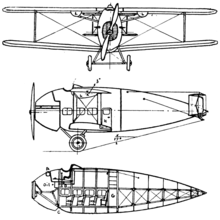Vickers Vulcan
The Vickers Vulcan was a British single-engine biplane airliner of the 1920s built by Vickers Limited at Brooklands Aerodrome, Surrey. It carried eight passengers and a pilot.
| Vulcan | |
|---|---|
_(tight_crop%2C_white_balanced%2C_grayscale).jpg) | |
| Vickers Vulcan Type 61 | |
| Role | Airliner |
| Manufacturer | Vickers |
| Designer | Rex Pierson |
| First flight | April 1922 |
| Introduction | 1 June 1922 |
| Retired | July 1928 |
| Primary users | Instone Air Line Imperial Airways |
| Produced | 1922–1925 |
| Number built | 8 |
Development
The Vickers Vulcan was designed by Rex Pierson of Vickers. It first flew in April 1922 at the hands of chief test pilot, S. Cockerell, at Brooklands Aerodrome in Surrey, UK.
The Vulcan was based on a civil version of the Vimy bomber, but featured many changes, including a much larger, taller fuselage and one, instead of two, Rolls-Royce Eagle VIII engines, the intention being low operating costs. The shape of its fuselage, as well as its flying characteristics, earned it the nickname "Flying Pig". The first delivery took place in August 1922, to Instone Air Line Ltd. Other operators included Imperial Airways and Qantas (however, the latter returned the aircraft as their performance was too poor for the company's needs). The last Vulcan flying was a Type 74 with Imperial Airways. It crashed in July 1928.
Variants
- Type 61 - first production version
- Type 63 - cargo version based on the Type 61
- Type 74 - upgraded to 450 hp Napier Lion engine
Operators
Individual aircraft
- G-EBBL; Type 61 - Prototype, first flew in April 1922, delivered to Instone Air Line in June 1922 as "City of Antwerp", sold to Imperial Airways, scrapped at Croydon Airport in May 1924.
- G-EBDH; Type 61 - Delivered to Instone Air Line in July 1922, accident at Oxted, Surrey, in 1922. returned to Vickers at Brooklands and withdrawn from use in 1923.
- G-EBEA; Type 61 - Delivered to Instone Air Line in July 1922 as "City of Brussels", returned to Vickers at Brooklands and withdrawn from use in 1923.
- G-EBEK; Type 63 - Delivered to Air Ministry at Martlesham Heath in November 1922 with Eagle IX for freighter trials, converted to passenger layout in 1925, scrapped in 1926.
- G-EBEM; Type 61 - Delivered to Douglas Vickers MP in September 1922, competed in King's Cup Air Race in September 1922, taking 7th place, disappeared off the coast of Italy in May 1926.
- G-EBES; Type 61 - Intended for Qantas, scrapped before completion.
- G-EBET; Type 61 - Delivered to Qantas in November 1922, returned, fate unknown but probably scrapped.
- G-EBFC; Type 74 - Delivered to Douglas Vickers MP January 1923, competed in King's Cup Air Race in 1923 (retired from the race), sold to Imperial Airways in January 1925, withdrawn from service in December 1925 and scrapped at Croydon in 1927.
- G-EBLB; Type 74 - Delivered to Imperial Airways in May 1925, crashed at Purley July 1928.
Specifications (Vulcan Type 74)

Data from Vickers Aircraft Since 1908[1]
General characteristics
- Crew: 1
- Capacity: 6–8 passengers
- Length: 38 ft 0 in (11.58 m)
- Wingspan: 49 ft 0 in (14.94 m)
- Height: 14 ft 3 in (4.34 m)
- Wing area: 840 sq ft (78 m2)
- Empty weight: 4,400 lb (1,996 kg)
- Gross weight: 6,750 lb (3,062 kg)
- Powerplant: 1 × Napier Lion 12-cylinder water-cooled broad arrow piston engine, 450 hp (340 kW)
Performance
- Maximum speed: 112 mph (180 km/h, 97 kn) at sea level
- Range: 460 mi (740 km, 400 nmi)
- Service ceiling: 10,500 ft (3,200 m)
- Rate of climb: 500 ft/min (2.5 m/s)
- Time to altitude: 13 min to 5,000 ft (1,500 m)
See also
Related development
Aircraft of comparable role, configuration and era
Sources
- Andrews, C.F and Morgan, E.B. Vickers Aircraft since 1908. London:Putnam, 1988. ISBN 0-85177-815-1.
- The Vickers "Vulcan" Eight-passenger Commercial Biplane Flight 4 May 1922 p253-258